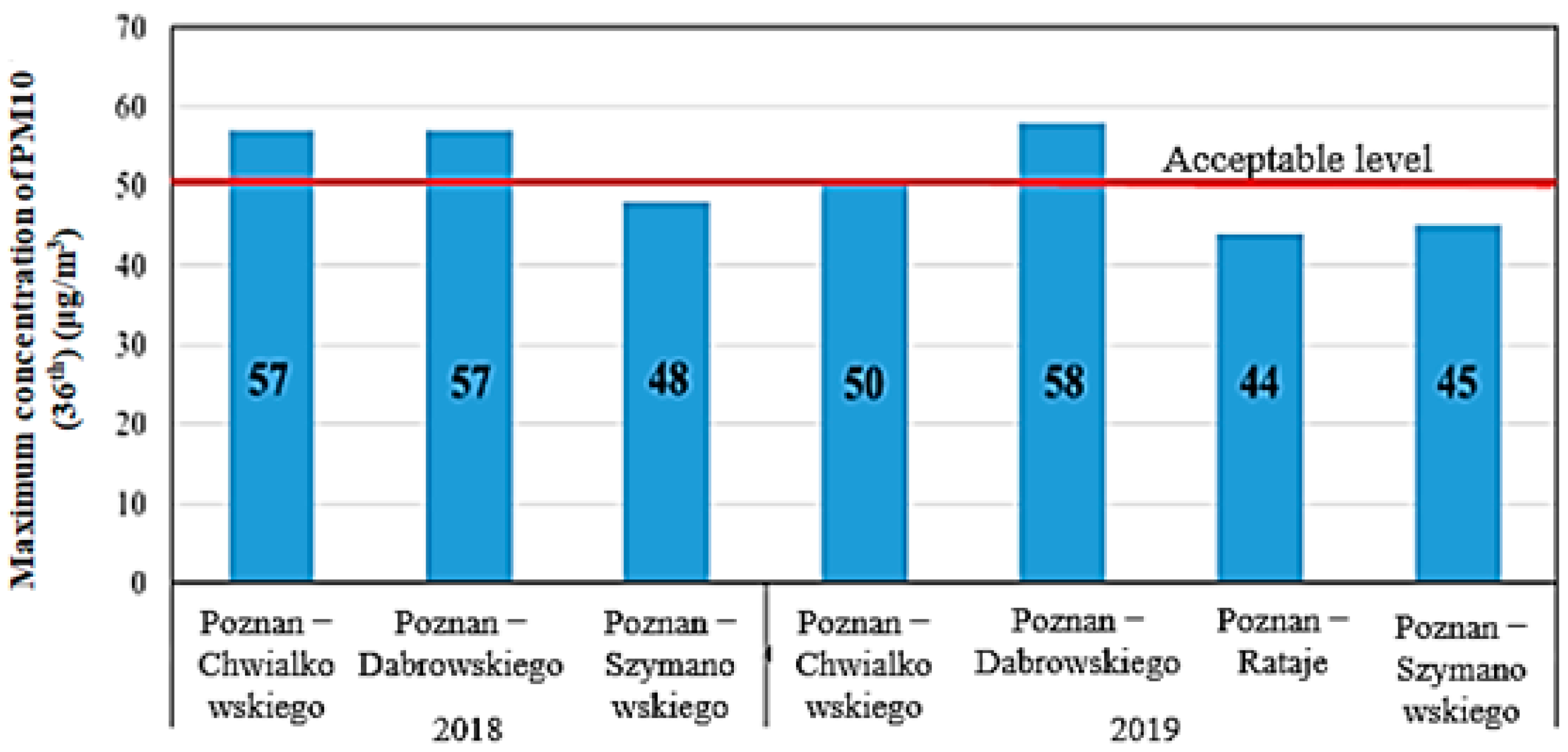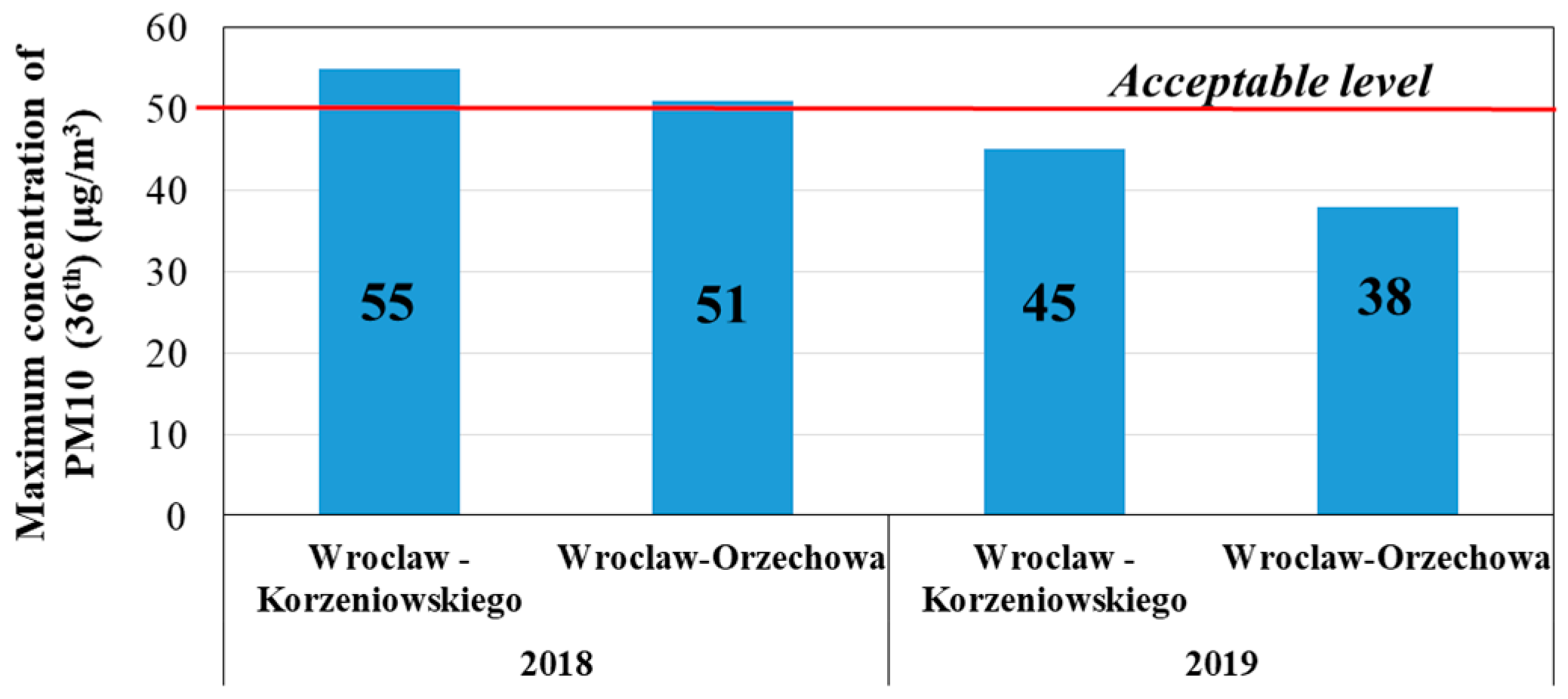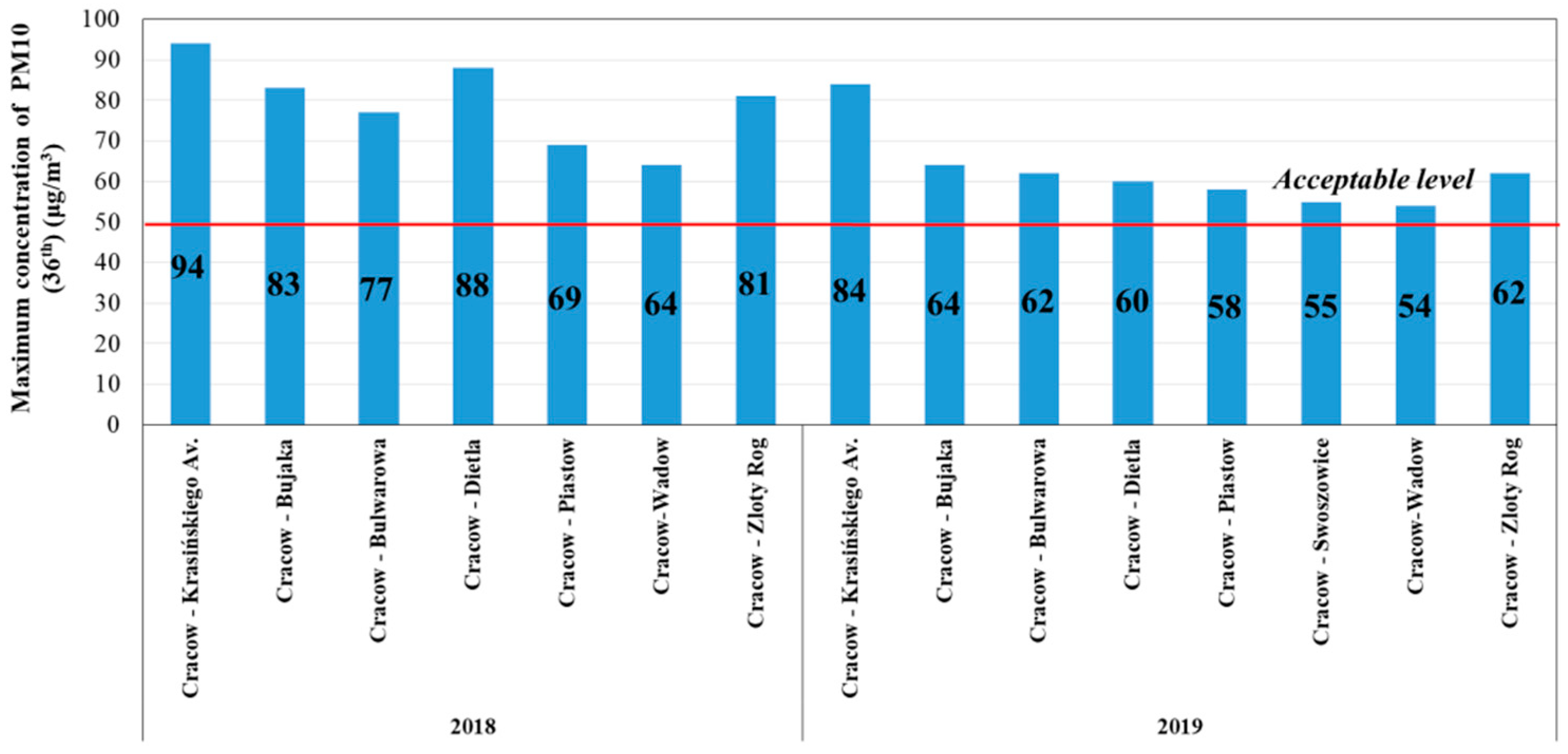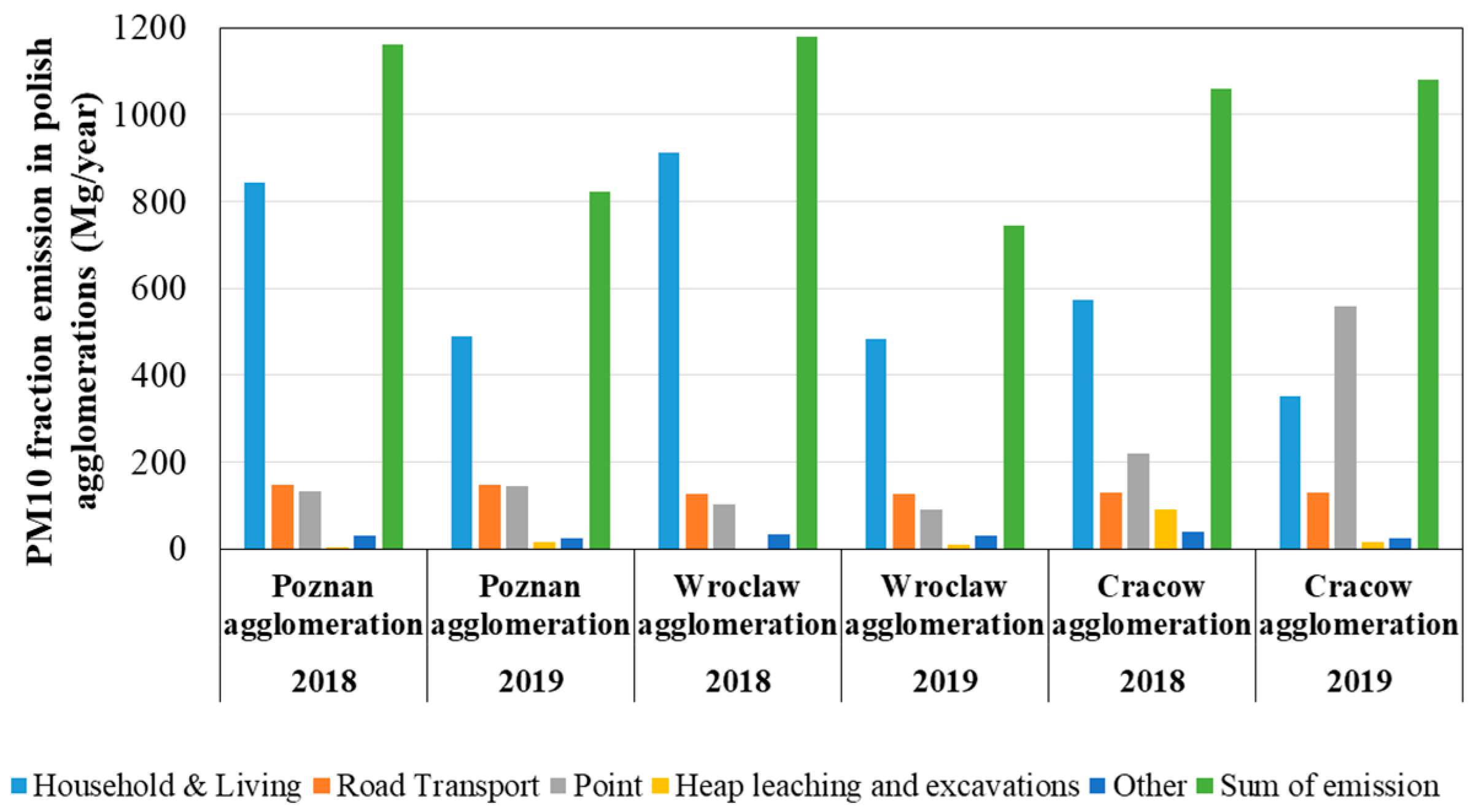Emissions and Concentrations of Particulate Matter in Poznan Compared with Other Polish and European Cities
Abstract
:1. Introduction
- PM10 (40 µg/m3),
- PM2.5 (25 µg/m3).
2. Materials and Methods
3. Results
3.1. Comparison of Particulate Matter Emissions in Poznan with Other Cities
3.1.1. Comparison with European Cities
- Bergstraße,
- Winckelmannstraße,
- Nord.
- Bratislava-Jeséniova,
- Bratislava-Kamienne namestie,
- Bratislava-Trnawskie myto,
- Bratislava-Mamatejowa.
3.1.2. Comparison with Other Polish Cities
3.2. Measurements in Poznan
4. Discussion
5. Conclusions
Author Contributions
Funding
Institutional Review Board Statement
Informed Consent Statement
Data Availability Statement
Conflicts of Interest
References
- European Environment Agency. Air Pollution. Available online: https://www.eea.europa.eu/pl/themes/air/intro (accessed on 9 August 2020).
- Jasinski, R. Number and mass analysis of particles emitted by aircraft engine. MATEC Web Conf. 2017, 18, 00023. [Google Scholar] [CrossRef]
- Kryzia, D.; Pepłowska, M. The impact of measures aimed at reducing low-stack emission in Poland on the energy efficiency and household emission of pollutants. Energy Policy J. 2019, 22, 121–132. [Google Scholar] [CrossRef]
- Directive 2004/107/EC of the European Parliament and of the Council of 15 December 2004 Relating to Arsenic, Cadmium, Mercury, Nickel and Polycyclic Aromatic Hydrocarbons in Ambient Air, L 23/3, 2004. Available online: https://www.eumonitor.eu/9353000/1/j9vvik7m1c3gyxp/vitgbgig0qzr (accessed on 10 August 2020).
- Directive (EU) 2016/2284 Of The European Parliament and of the Council of 14 December 2016. Available online: https://www.legislation.gov.uk/eudr/2016/2284/contents (accessed on 10 August 2020).
- Directive 2008/50/EC of the European Parliament and of the Council of 21 May 2008 on Ambient air Quality and Cleaner Air for Europe, L 152. Available online: https://eur-lex.europa.eu/legal-content/en/ALL/?uri=CELEX%3A32008L0050 (accessed on 10 August 2020).
- EEA Report No 5/2020. European Union Emission Inventory Report 1990–2018 under the UNECE Convention on Long-Range Transboundary Air Pollution (LRTAP); Publications Office of the European Union: Luxembourg; Copenhagen, Denmark, 2020. [Google Scholar]
- European Environment Agency. Air Quality in Europe—2019 Report. Available online: https://www.eea.europa.eu/publications/air-quality-in-europe-2019 (accessed on 9 August 2020).
- Commission Regulation (EU) 2018/1832 of 5 November 2018 Amending Directive 2007/46/EC of the European Parliament and of the Council, Commission Regulation (EC) No 692/2008 and Commission Regulation (EU) 2017/1151 for the Purpose of Improving the Emission Type Approval Tests and Procedures for Light Passenger and Commercial Vehicles, Including Those for In-Service Conformity and Real-Driving Emissions and Introducing Devices for Monitoring the Consumption of Fuel and Electric Energy (OJ L 301, 27.11.2018, pp. 1–314). Available online: https://eur-lex.europa.eu/legal-content/GA/TXT/?uri=CELEX:32018R1832 (accessed on 10 August 2020).
- Sokolnicka-Popis, B.; Szymlet, N.; Siedlecki, M.; Gallas, D. The impact of particulate filter substrate type on the gaseous exhaust components emission. Combust. Engines 2020, 183, 58–62. [Google Scholar] [CrossRef]
- Zhang, N.; Huang, H.; Duan, X.; Jinlong, Z.; Su, B. Quantitative Association Analysis between PM2.5 Concentration and Factors on Industry, Energy, Agriculture, and Transportation; Scientific Reports; Nature Publishing Group: Berlin, Germany, 2018. [Google Scholar] [CrossRef]
- Atlas of Air Quality Zones and Monitoring Stations 2013&2014, Slovakia; DG Environment: Brussels, Belgium, 2014.
- Discomap. Available online: eea.europa.eu (accessed on 3 February 2021).
- Dresden. Luftreinhalteplanfür die Landeshauptstadt Dresden 2017, Dresden, 2019. Available online: https://www.dresden.de (accessed on 9 August 2020).
- Národný Program Znižovania Emisií; Ministerstvo Zivotneho Prostredia Slovenskej Rebubliky: Bratislava, Slovakia, 2020.
- Technical Data of Optical Particle Sizer 3330. Available online: https://tsi.com/products/particle-sizers/particlesize-spectrometers (accessed on 12 August 2020).
- Bratislava in Figures; Statistical Office of the Slovak Republic: Bratislava, Slovakia, 2019.
- Dresden. AllgemeineLuftbelastung. Available online: https://www.dresden.de (accessed on 9 August 2020).
- POZnan. City Activities to Improve Air Quality. Available online: https://www.poznan.pl/mim/main/en/ (accessed on 11 August 2020).
- Sachsen.de, Aktuelle Messwerte. Available online: https://www.luft.sachsen.de/aktuelle-messwerte-15045.html (accessed on 9 August 2020).
- Slovak Hydrometeorological Institute, Department Of Emissions and Air Quality Monitoring. Air Pollution in the Slovak Republic in 2015; Ministry of Environment of the Slovak Republic: Bratislava, Slovakia, 2017.
- Dresden. Bevölkerungsbestand. Available online: https://www.dresden.de (accessed on 9 August 2020).
- Informácia o Kvalite Ovzdušia a Podiele Stacionárnych Zdrojov na Znečisťovaní Ovzdušia, o Programoch na Zlepšenie Kvality Ovzdušia a Akčných Plánoch v Bratislavskom Kraji; Oddelenie Štátnej Správy vôd a Vybraných Zložiek Životného Prostredia Kraja Žilina, Slovakia; The Ministry of Interior of the Slovak Republic: Bratislava, Slovakia, 2017.
- Pausch, A.; Franke, J.; Löschau, G.; Mühlner, M. Luftqualität in Sachsen-Jahresbericht 2018; Sächsische Staatskanzlei: Freistaat Sachsen, Germany, 2018.
- Pausch, A.; Franke, J.; Löschau, G.; Straková, M.; Mannewitz, A. Luftqualität in Sachsen-Jahresbericht 2017; Sächsische Staatskanzlei: Freistaat Sachsen, Germany, 2017.
- Správa o Kvalite Ovzdušia v Slovenskej Republike, 2018; Slovenský Hydrometeorologický Ústav: Bratislava, Slovakia, 2019.
- Regional Department of Environmental Monitoring in Poznan. Annual Assessment of Air Quality in the Lesser Poland Voivodeship, Voivodeship Report for 2019; Regional Department of Environmental Monitoring in Poznan: Poznań, Poland, 2020.
- Regional Department of Environmental Monitoring in Poznan. Annual Assessment of Air Quality in the Lesser Poland Voivodeship, Voivodeship Report for 2018; Regional Department of Environmental Monitoring in Poznan: Poznań, Poland, 2019.
- Report on the State of Current National Legislation and Policies to Improve the Air Quality; Interreg Central Europe: Vienna, Austria, 2018.
- Regional Department of Environmental Monitoring in Cracow. Annual Assessment of Air Quality in the Lesser Poland Voivodeship, Voivodeship Report for 2018; Regional Department of Environmental Monitoring in Cracow: Kraków, Poland, 2019.
- Regional Department of Environmental Monitoring in Wroclaw. Annual Assessment of Air Quality in the Lesser Poland Voivodeship, Voivodeship Report for 2019; Regional Department of Environmental Monitoring in Wroclaw: Wrocław, Poland, 2020.
- Regional Department of Environmental Monitoring in Wroclaw. Annual Assessment of Air Quality in the Lesser Poland Voivodeship, Voivodeship Report for 2018; Regional Department of Environmental Monitoring in Wroclaw: Wrocław, Poland, 2019.
- Report: Solid Fuel Heat Sources in Residential Buildings; Wrocław University of Technology, Research Center for Sustainable Built Environment RoSE: Wrocław, Poland, 2019.
- Poznan–Measurement Data of Air Quality. Available online: powietrze.poznan.wios.gov.pl/dane-pomiarowe/ (accessed on 2 February 2021).
- Regional Department of Environmental Monitoring in Cracow. Annual Assessment of Air Quality in the Lesser Poland Voivodeship, Voivodeship Report for 2019; Regional Department of Environmental Monitoring in Cracow: Kraków, Poland, 2020.
- Regional Annual Air Quality Assessment in the Greater Poland Voivodeship for 2017; Chief Inspectorate for Environmental Protection in Poznan: Poznan, Poland, 2018.
- Stations’ Browser. Available online: https://powietrze.gios.gov.pl/pjp/station/search (accessed on 7 August 2020).
- Website of KAWKA Project Plus Realized in Wroclaw. Available online: https://zmienpiec.pl/kawka-plus (accessed on 10 August 2020).
- MOCH, B. Learn about Renewable Energy Sources. 2019. Available online: https://www.wroclaw.pl/srodowisko/poznaj-oze/czerwiec (accessed on 9 August 2020).
- Jasinski, R. Mass and number analysis of particles emitted during aircraft landing. E3S Web Conf. 2018, 44, 00057. [Google Scholar] [CrossRef]
- Regional Annual Air Quality Assessment in the Greater Poland Voivodeship for 2018; Chief Inspectorate for Environmental Protection in Poznan: Poznan, Poland, 2019.
- Airly.eu. Available online: https://airly.org/pl/ (accessed on 10 August 2020).
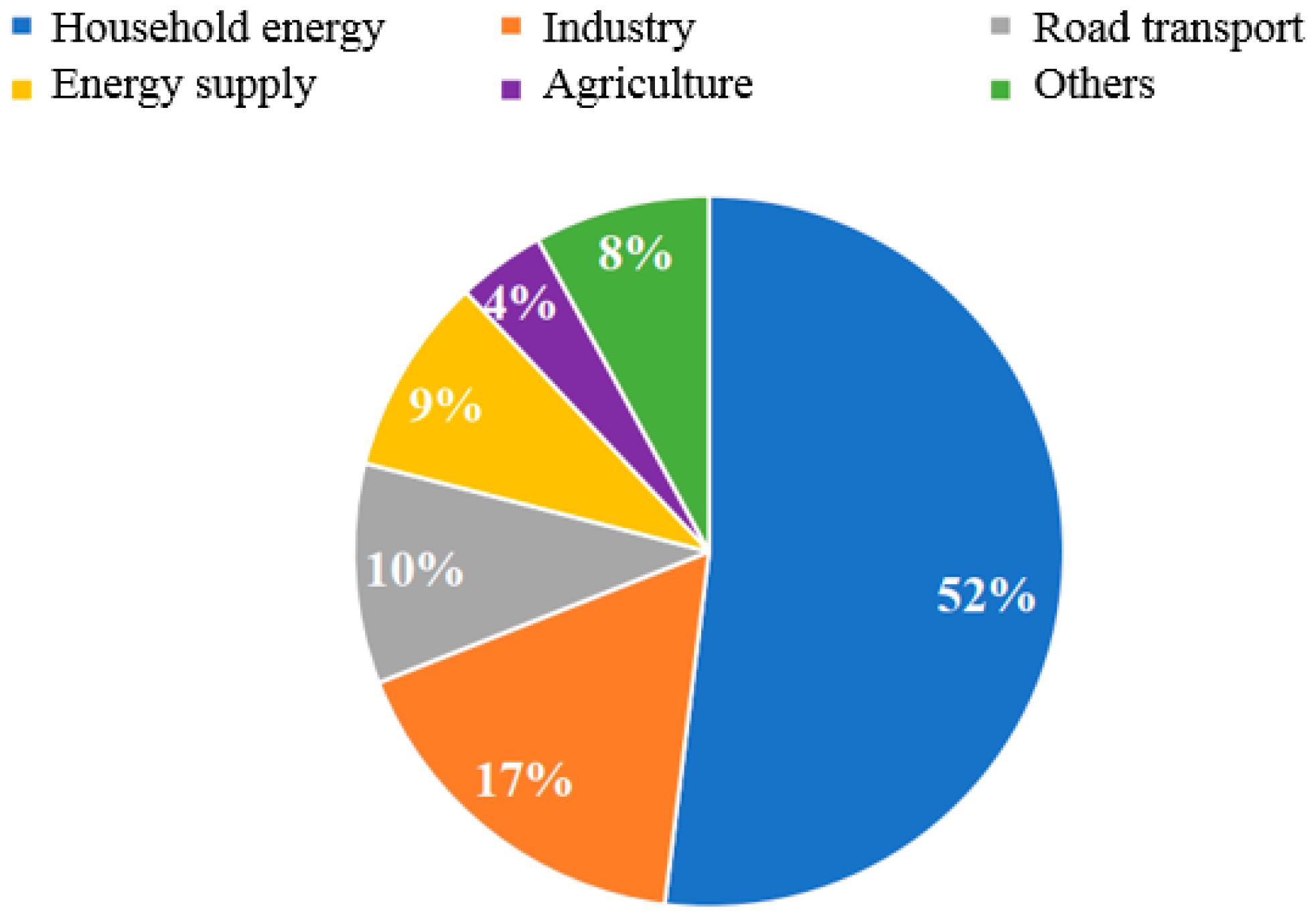

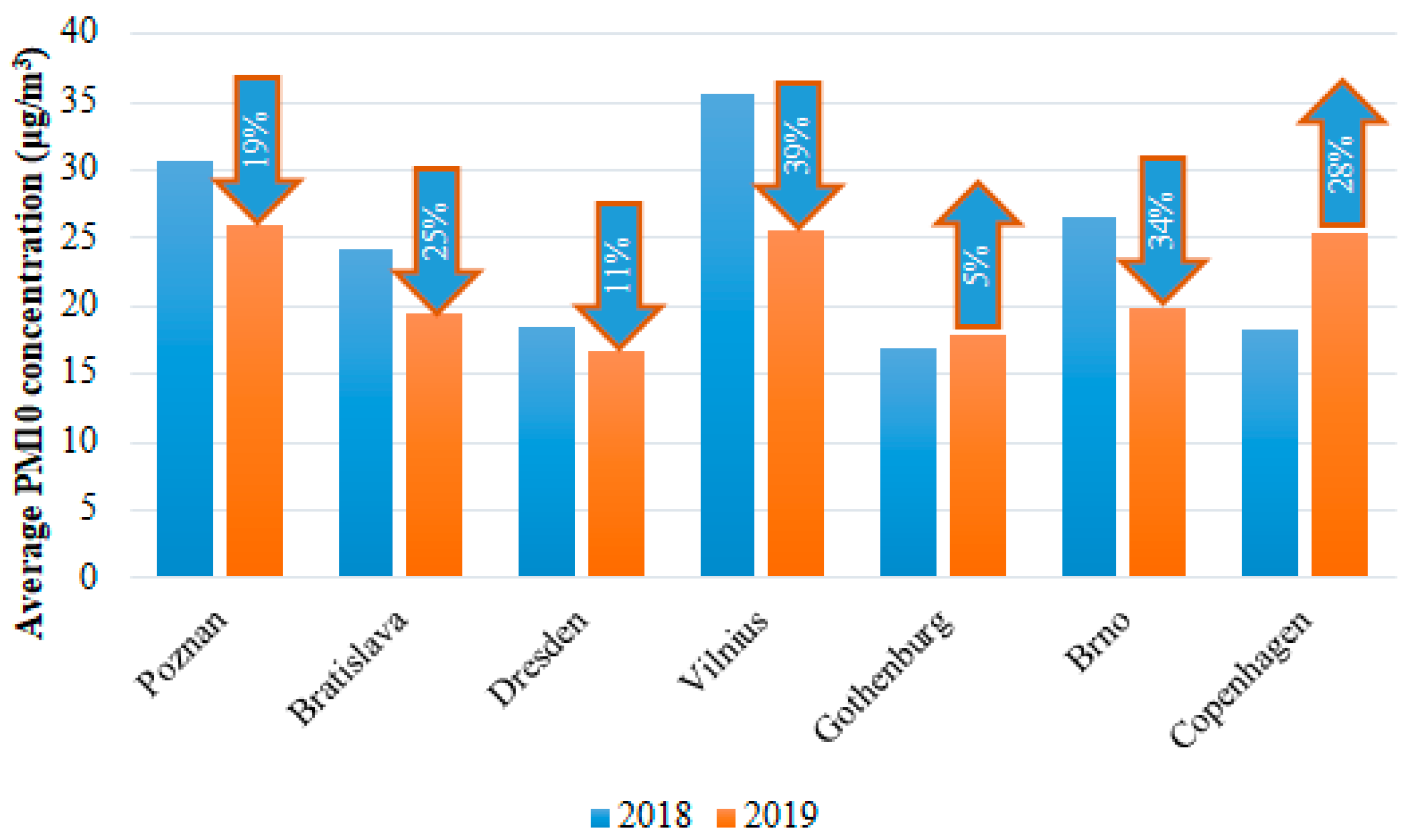


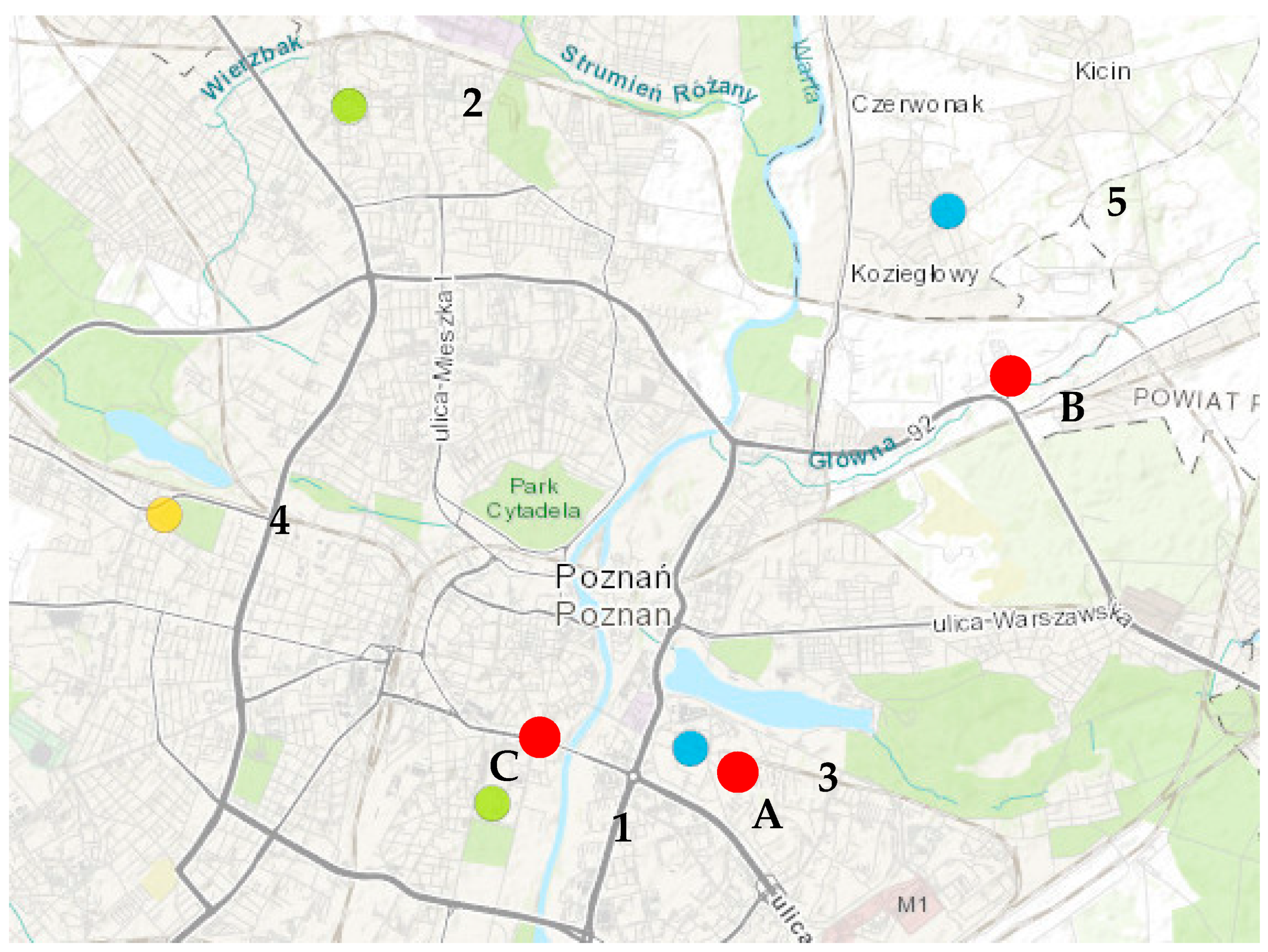
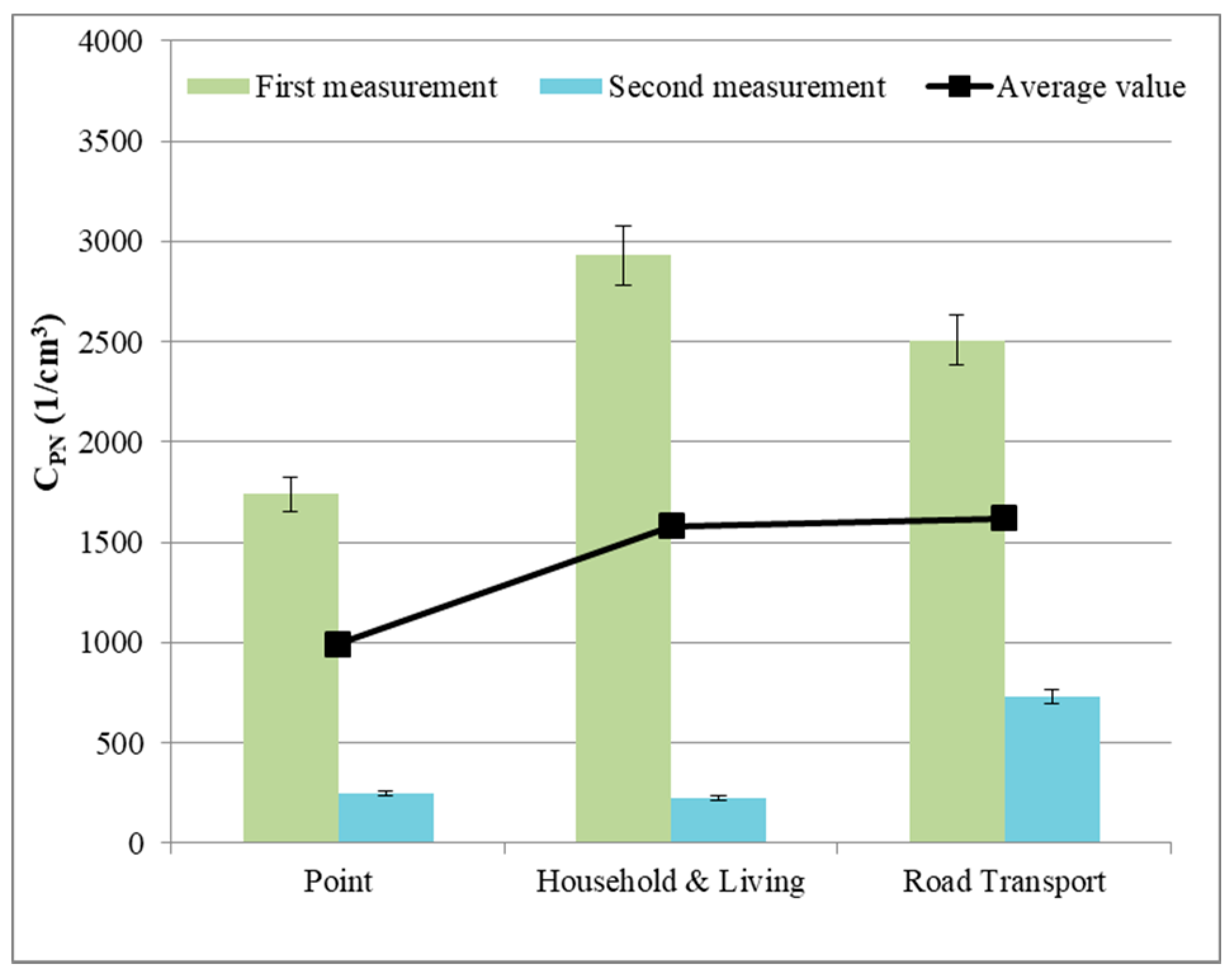

| City | Area (km2) | Population Density (People per km2) | No. of Measuring Stations |
|---|---|---|---|
| Poznan | 262 | 2042 | 4 |
| Dresden | 328 | 1697 | 3 |
| Bratislava | 368 | 1174 | 4 |
| City | Station | 2017 | 2018 | 2019 |
|---|---|---|---|---|
| Poznan | Polanka | 26 | - | 26 |
| Dabrowskiego | 29 | 32 | 30 | |
| Szymanowskiego | 27 | 28 | 25 | |
| Chwialkowskiego | 30 | 31 | 28 | |
| Dresden | Bergstraße | 21 | 23 | 17 |
| Nord | 20 | 22 | 19 | |
| Winckelmannstraße | 17 | 18 | 15 | |
| Bratislava | Kamenné námestie | 19 | 26 | 22 |
| Trnavské mýto | 25 | 29 | 24 | |
| Jeséniova | 20 | 24 | 19 | |
| Mamateyowa | 23 | 26 | 21 |
| City | Area (km2) | Population Density (People per km2) | No. of Measuring Stations |
|---|---|---|---|
| Poznan | 262 | 2042 | 4 |
| Wroclaw | 293 | 2195 | 4 |
| Cracow | 327 | 2384 | 8 |
| City | Station | 2017 | 2018 | 2019 |
|---|---|---|---|---|
| Poznan | Polanka | 26 | – | 26 |
| Dabrowskiego | 29 | 32 | 30 | |
| Szymanowskiego | 27 | 28 | 25 | |
| Chwialkowskiego | 30 | 31 | 28 | |
| Wroclaw | Korzeniowskiego | 30 | 32 | 26 |
| Orzechowa | 29 | 29 | 22 | |
| Cracow | Krasinskiego | 55 | 56 | 50 |
| Bujaka | 43 | 43 | 35 | |
| Bulwarowa | 42 | 37 | 34 | |
| Dietla | 49 | 47 | 35 | |
| Piastow | 38 | 36 | 31 | |
| Waldow | – | 33 | 29 | |
| Zloty Rog | 44 | 42 | 35 | |
| Swoszowice | – | – | 31 |
| City | Station | 2018 | 2019 |
|---|---|---|---|
| Poznan | Polanka | - | 27 |
| Dabrowskiego | 53 | 54 | |
| Szymanowskiego | 29 | 23 | |
| Chwialkowskiego | 45 | 34 | |
| Wroclaw | Korzeniowskiego | 48 | 25 |
| Orzechowa | 37 | 11 | |
| Cracow | Krasinskiego | 161 | 125 |
| Bujaka | 92 | 68 | |
| Bulwarowa | 68 | 63 | |
| Dietla | 103 | 57 | |
| Piastow | 69 | 52 | |
| Waldow | 58 | 40 | |
| Zloty Rog | 96 | 65 | |
| Swoszowice | – | 49 |
Publisher’s Note: MDPI stays neutral with regard to jurisdictional claims in published maps and institutional affiliations. |
© 2021 by the authors. Licensee MDPI, Basel, Switzerland. This article is an open access article distributed under the terms and conditions of the Creative Commons Attribution (CC BY) license (https://creativecommons.org/licenses/by/4.0/).
Share and Cite
Jasiński, R.; Galant-Gołębiewska, M.; Nowak, M.; Kurtyka, K.; Kurzawska, P.; Maciejewska, M.; Ginter, M. Emissions and Concentrations of Particulate Matter in Poznan Compared with Other Polish and European Cities. Atmosphere 2021, 12, 533. https://doi.org/10.3390/atmos12050533
Jasiński R, Galant-Gołębiewska M, Nowak M, Kurtyka K, Kurzawska P, Maciejewska M, Ginter M. Emissions and Concentrations of Particulate Matter in Poznan Compared with Other Polish and European Cities. Atmosphere. 2021; 12(5):533. https://doi.org/10.3390/atmos12050533
Chicago/Turabian StyleJasiński, Remigiusz, Marta Galant-Gołębiewska, Mateusz Nowak, Karolina Kurtyka, Paula Kurzawska, Marta Maciejewska, and Monika Ginter. 2021. "Emissions and Concentrations of Particulate Matter in Poznan Compared with Other Polish and European Cities" Atmosphere 12, no. 5: 533. https://doi.org/10.3390/atmos12050533
APA StyleJasiński, R., Galant-Gołębiewska, M., Nowak, M., Kurtyka, K., Kurzawska, P., Maciejewska, M., & Ginter, M. (2021). Emissions and Concentrations of Particulate Matter in Poznan Compared with Other Polish and European Cities. Atmosphere, 12(5), 533. https://doi.org/10.3390/atmos12050533






